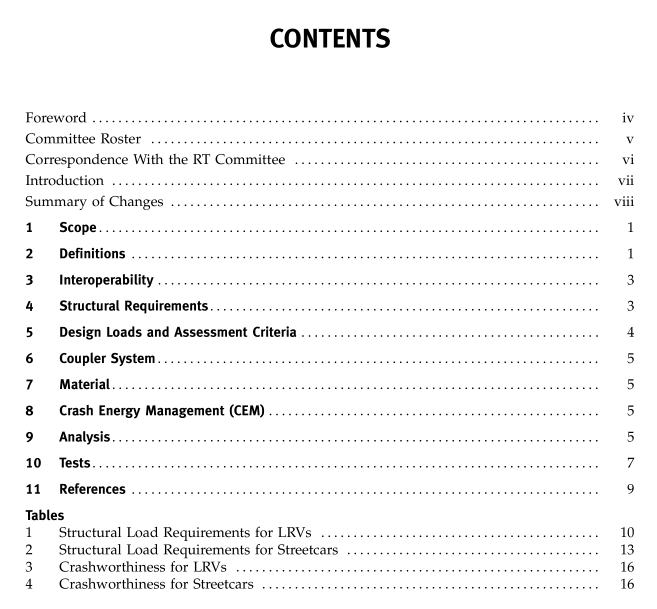ASME RT-1 pdf download

ASME RT-1 pdf download Safety Standard for Structural Requirements for Light Rail Vehicles
3 INTEROPERABILITY This section covers geometric compatibility and crush mechanism design considerations for different vehicles operating on the same routes of the subject transit system.
3.1 Anticlimber and Coupler Interface Each light rail vehicle shall incorporate an anticlimber at each end of the vehicle. The height and design of the anticlimber and coupler on new light rail vehicles shall be compatible with existing light rail vehicles that are operated on the same routes of the customer’s transit system. The anticlimber shall be designed for engage- ment between vehicles to mitigate override or telescop- ing in a collision, including any condition of failed or deflated suspension elements. In the event of a collision with another rail vehicle, the coupler system shall include a feature that will permit engagement of anticlimbers. See section 6 for additional requirements. Design of the vehicle leading end structure shall not interfere with proper engagement or operation of the vehicle anticlimber system.
3.2 LRV and Streetcar Leading End Design for Protection of Street Vehicles Forlightrail vehiclesand streetcarsoperatinginurban environments sharing roadways and crossings, the design of the leading end of the carbody shall incorpo- rate a contoured geometry shape extending across the width of the vehicle, enclosing open area spaces to encourage deflection of struck objects from the path of the LRV/streetcar and to minimize entrapment, over- ride, and penetration of automobiles and light trucks. Sharp corners and protruding shapes of the contoured geometry design shall be minimized. A bumper, coupler enclosure, pilot beam, skirting, and/or alternative struc- tures may be used to achieve these objectives. The bottom of the car end structures as described in the previous paragraph, with nominal floor height conditions, shall notbe greater than the larger of250 mm (10in.) abovethetop ofrailorthe minimumallowable by the dynamic operating envelope. The leading end design shall take into account colli- sion compatibility with automotive construction. NOTE: Side structures for typical automobiles and light trucks are designed for load-bearing reinforcement at a height above the roadway surface ranging from 250 mm (10 in.) to 635 mm (25 in.). Matching the leading end geometry and structural design of the LRV/streetcar to this height reduces the likelihood of LRV/street- car penetration into passenger compartments of these vehicles, thus reducing injury propensity. See SAE Paper No. 1999-01-0071. 4 STRUCTURAL REQUIREMENTS The carbody shall withstand the maximum loads con- sistent with the operational requirements and achieve 3 the required service life under normal operating condi- tions. The carbody design shall be based on the design load requirements specified in section 5.
The capability ofthe structure to meet these requirements shall be dem- onstrated by calculation and/or appropriate proof-of- design testing. The vehicle is assumed to be of double- end design with an operating cab at either end. If the vehicle is of single-end design, the rear of the vehicle should be ofequivalent design and, in a collision, should respond in the same manner as the front end. The strength of connections between structural mem- bers for all structural loading requirements outlined in Tables 1 and 2 shall exceed the ultimate load-carrying capacity of the weakest member joined. For these load cases, the ultimate load-carrying capacity is defined by applying the load at the location and in the direction specified in Tables 1 and 2, but increased in magnitude to the maximum load that can be resisted by the struc- ture, as determined by observing that further increase in deflection will result in a decrease in the load capable of being carried by the structure.
4.1 Welding Design of welded structures shall be in accordance with AWS D1.1/D1.1M for steel and AWS D1.2/D1.2M for aluminum, or equivalent.
4.2 Articulation The articulation shall include structure to meet the requirements of section 5.
4.3 Design Parameter Tolerances The allowable stresses for the loads specified in section 5 shall consider the limiting cases ofdimensional tolerances, manufacturingprocesses, workmanship, and other manufacturing conditions. 4.4 Demonstration of Strength and Structural Stability Itshall be demonstrated by analysis (section9) and/or tests (section 10) that the requirements of section 5 are achieved.









